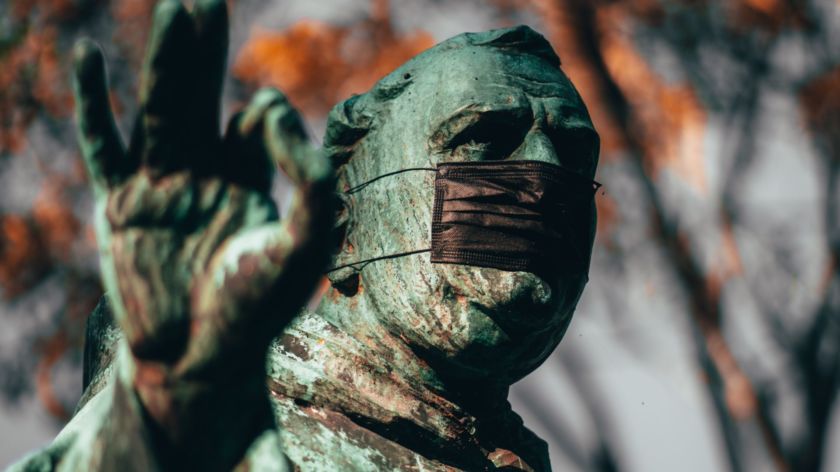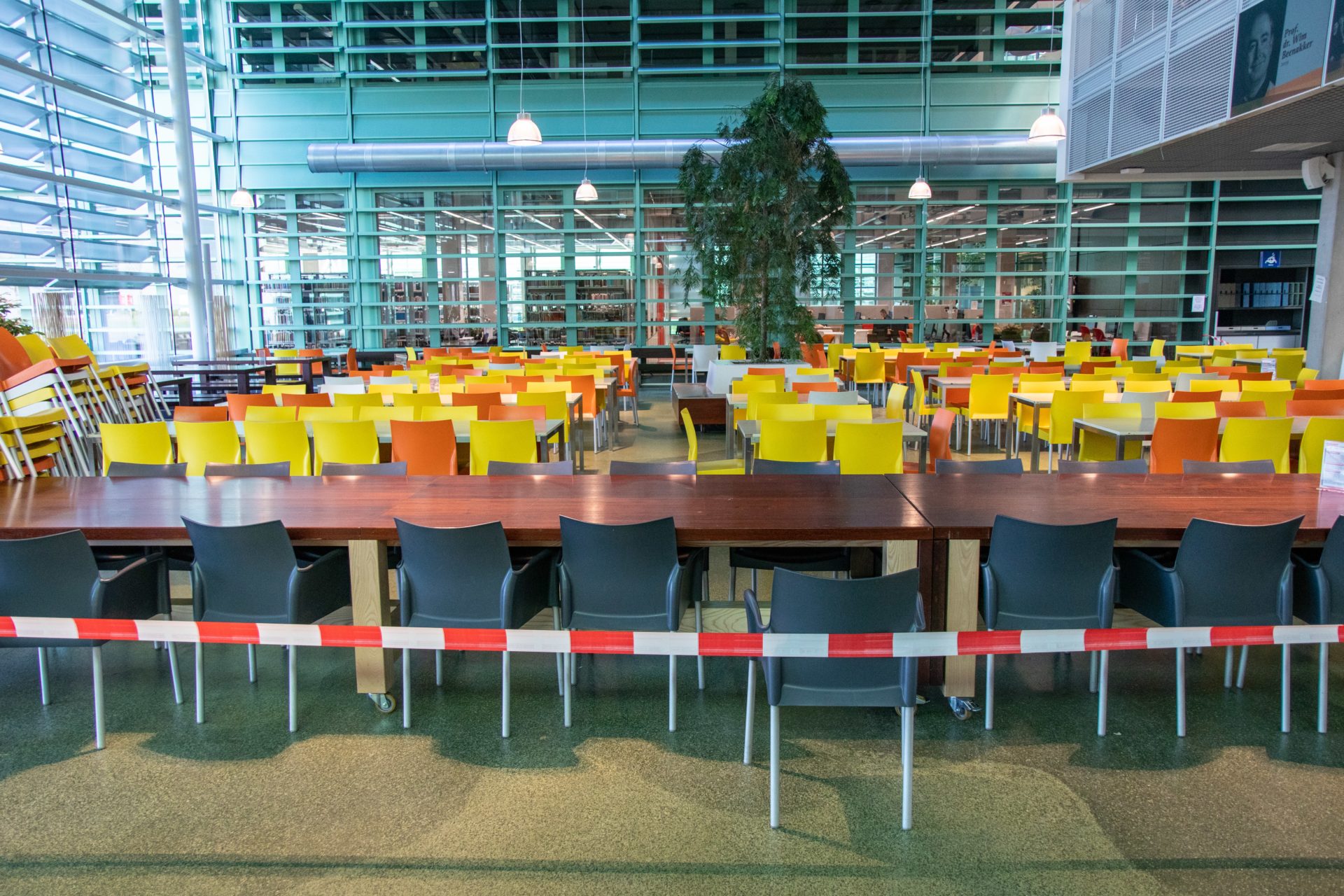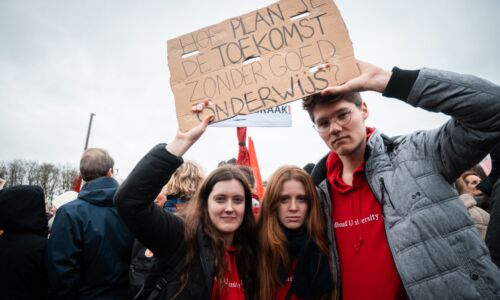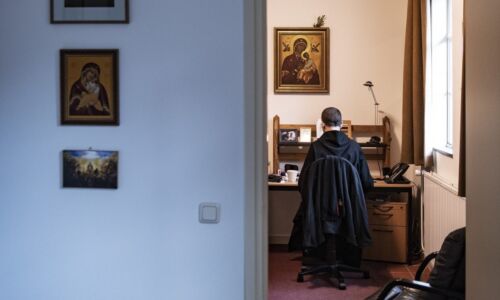As we reach the end of the second COVID-19 pandemic year, the end seems nowhere in sight: ‘We’ll probably soon see another wave’
-
 Thomas van Aquino, faithfully sporting his face mask since the start of the pandemic. Photography: Johannes Fiebig
Thomas van Aquino, faithfully sporting his face mask since the start of the pandemic. Photography: Johannes Fiebig
The COVID-19 pandemic has dominated our day-to-day life for nearly two years. Is the situation slowly becoming hopeless, or does 2022 promise to be a better year? ‘We will live to see a ‘post-COVID-19’ era,’ promises Professor of Outbreaks of Infectious Diseases Chantal Bleeker-Rovers.
High infection rates, overflowing ICUs, postponed operations, concerns about the far more infectious Omicron variant, and hospitals forced to put security guards at their doors. While everyone had all hoped that the vaccine would guarantee a winter free of COVID-19 perils, we find ourselves once again facing strict measures. Last weekend, the Dutch government even announced another hard lockdown – lasting at least until 14 January.
New lockdown
This interview with Chantal Bleeker-Rovers took place last week, thus predating last Saturday’s announcement of a new full lockdown by the Dutch government.
Over the past months, Professor of Outbreaks of Infectious Diseases and Radboudumc internist Chantal Bleeker-Rovers repeatedly shared her views on social media and in the press. Even before the recent concerns about the Omicron variant and this week’s lockdown, she expressed her fear that the dire situation in the overflowing hospitals was unlikely to change any time soon without additional measures. What is her perspective on the current situation?
Reflecting on 2021, what do you see?
‘That’s a difficult question. So much has happened. At the start of the year, we were hopeful because the vaccines were on their way. This is an important difference with last winter: without the vaccines, we would really be in a different situation, with far more measures and restrictions (that ended up being announced anyway last weekend, see box, Eds.). We would also not have been able to keep regular healthcare open, although it is arguable to what extent we’re able to keep it open now.’
‘But on the other hand, last winter we were also slightly more optimistic about where we would be a year later. Unfortunately, this optimism was misplaced. This is a setback for us all.’
Everyone seemed to agree that the vaccine would guarantee that no strict measures would be required this winter. But this turned out to be incorrect. Why?
‘The reality is of course a lot more complicated. Let one thing be clear: the vaccines are extremely important. They reduce infection severity and the odds of people ending up in hospital. The ratio of hospital admissions to infections is much lower now than last winter. But to get an infectious disease under control, you need more: for example basic rules and clarity.’
‘The latter has unfortunately been lacking at times. Take the booster vaccine: it’s hardly strange that you need a booster for a vaccine. Paediatric vaccines also require second and third shots. It quickly became apparent that two shots (or one, in the case of the Janssen vaccine, Eds.) would not be enough to prevent infection. The Dutch government consistently communicated that the vaccine was going to save us. But the vaccine alone was never going to be enough, and this is something that has been given too little attention.’
But will the vaccine and one booster shot be enough then?
‘We hope so, but we don’t know yet. Vaccines work on two fronts: they stimulate the production of antibodies and they boost cellular immunity. Antibodies reduce the odds of people becoming infected or infecting others. Cellular immunity combats the virus in a different way by reducing the severity of the infection. Over time, antibodies disappear, but we hope – and expect – that cellular immunity remains active. However, it’s too early to say anything conclusive about it. The odds are high that we’ll have to continue to offer vulnerable groups a yearly booster, as we do with the flu.’
Last summer, you expressed your concern about the government’s decision to let go of all measures. In view of the infection and hospitalisation rates of the past months, this turned out to be a legitimate concern.
‘Yes, that was a real pity. If we had kept just a few measures, we would not be in this terrible situation now. And we’d have had more breathing space now that a new variant has emerged – something that was incidentally also predicted. I’m still of the opinion that many general lighter measures should have been kept, such as face masks and the 1.5 metres rule. Another important factor is enough testing capacity and high quality source investigation and contact tracing, which allows us to prevent many infections, and therefore hospitalisations.’
The Christmas holiday started a week earlier and the so-called ‘evening lockdown’ was prolonged. As of writing, we are even once again in a full lockdown. What will be the effect of these measures?
‘We’re currently in a difficult starting situation. Infection rates are high, the hospitals are full, there are hardly any ICU beds left, and much regular healthcare has been postponed. We’re still only inches away from code black in hospitals – and this will remain the case for some time. Hospitalisation numbers have finally stabilised, which is definitely better than if they were still rising. But it’s not enough.’
‘We’re still only inches away from code black – and this will remain the case for some time’
‘Add to this the fact that many people find it difficult to limit their contacts and keep distance during the holiday season. I expect infections to increase in the coming weeks, and I’m concerned about where we’ll be in January, especially now that the Omicron variant is on the rise, and will soon become the dominant variant.’
Let’s talk about this Omicron variant, which we still don’t know much about. And yet, there are already concerns. As there were at first with the delta variant. Some people feared that the vaccines wouldn’t work against delta. This later turned out to be incorrect. Weren’t these concerns largely ungrounded?
‘No, I wouldn’t say that at all. What we see now, as we did with the delta variant, is that people tend to speculate a lot in the early days. But we still have to wait. Comparisons with other regions where the Omicron variant is already dominant, often don’t apply. South Africa, for example, has a lower vaccination rate, but relatively many people who have already gone through one or two COVID-19 infections. You cannot compare this to the situation in the Netherlands.’
‘What we do know is that the new variant is more infectious than the current delta variant. The antibodies people have without a booster are insufficient to protect them adequately. This means that Omicron will lead to more infections, and therefore also more hospitalisations. This is also one of the reasons why my colleagues are going out into the streets to provide information about the vaccine, and why we recently started helping out at the Twijfel Telefoon (a helpline for people who hesitate about getting vaccinated). Unfortunately, I still often see unvaccinated people in hospital who greatly regret not having gotten a vaccine. This is often due to a lack of information: they’ve allowed friends or relatives to convince them to not get vaccinated. I find this really frustrating.’

What can we expect in the year to come?
‘We will certainly face more difficulties. I’d love to be wrong about this, but there is no doubt that we are about to enter a new wave and I’m afraid that we’ll need even stricter measures to avoid code black. With the continuous threat of yet another new variant that might be totally resistant to the vaccine or hit vulnerable groups after all. I hope this won’t happen, but unfortunately, it cannot be excluded.’
‘Having said that, what I hope for is a far more optimistic scenario, one in which COVID-19 behaves as influenza does now: with a relatively low number of infections and a small surge in winter than can be absorbed by regular healthcare.’
Empty campus
With the new lockdown, the university grounds are once again nearly deserted. All schools, including universities, are closed at least until 9 January. Lectures and workgroups have once again moved online. Only practicals and other forms of practical learning are allowed to take place in person, at 1.5 metres distance. Examinations are allowed to proceed on campus. And the University Library (UB) remains open, with a maximum number of visitors per room. For a list of all the rules, see the Radboud University website.
What else is needed for this kind of optimistic scenario to unfold?
‘A clear roadmap for the various scenarios, so that everyone knows what additional measures will be introduced once we reach a predetermined number of infections or hospitalisations. That way, you don’t have to continuously debate about it.’
‘Clear communication is important in any case. Unfortunately, this is not something the Dutch government has consistently provided in the past two years. There has also been much discussion about wearing face masks. I don’t understand why it was suddenly announced last summer that face masks were no longer necessary. This only leads to confusion and discussion now that they’re once again compulsory. The same goes for testing: first people had to be tested at the GGD, now a self-test is enough. In this way, you create confusion and you completely lose track of the infections.’
This is all about preventing infections. But shouldn’t we also work on upscaling healthcare, to create a safety net?
‘Scaling up ICU capacity is not possible in the short term. Training the personnel alone takes years, and costs a lot of money. We need extra beds right now, but once infection rates drop, we’ll be stuck with a lot of expensive and empty beds. Plus, upscaling healthcare doesn’t prevent infections, it only postpones code black. By expanding ICU capacity and using this extra capacity before introducing measures, you’re factually accepting that more people will become severely ill or die before you intervene. And intervention remains necessary. It would be a good idea to explore options for temporarily expanding capacity in autumn and winter, to absorb the seasonal surge in infections.’
‘Scaling up ICU capacity is not possible in the short term’
Will we live to see a post-COVID-19 era?
‘In the long run, COVID-19 will become endemic: it’s an infectious disease that’s here to stay. We just have to make sure that it’s manageable. We’ve seen this before with new flu viruses, for example the one known as Mexican Flu, the New Influenza A (H1N1) virus. Many people think that it’s no longer around, but that’s not true. We do have it under control, though. And this requires a lot of hard work in the background: monitoring infections, protecting vulnerable groups with flu shots, and responding fast in case of an upsurge.’
‘COVID-19 will also lose some of its power. In the end, the worldwide degree of immunity will increase thanks to the vaccine or people going through multiple COVID-19 infections. As a result, more people will be protected, and the pressure on healthcare will drop. We will also have medicines to prevent people from becoming so severely ill that they end up in hospital, and we might introduce a yearly booster shot.’
‘COVID-19 is affecting us all, whether through infection, or because of the measures, or financial and other consequences. This feeling, that COVID-19 dominates our day-to-day life, will ebb in time. So there will be a time when we feel that we’ve reached a ‘post-COVID-19’ era, although it will take a lot of hard work to make it happen.’




